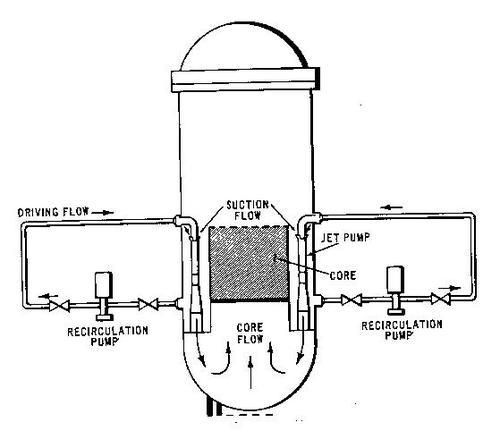
On April 25, 2012, workers prepared to restart the Fermi Unit 2 reactor in Michigan from a refueling outage. After the top, or “head,” had been placed back on the reactor vessel that houses the reactor core, procedures required operators to perform a hydrostatic pressure test to check that all the parts had been reassembled correctly.The reactor core remained shut down with all control rods fully inserted during the hydrostatic test. The operators started two large motor-driven pumps to recirculate water through the reactor vessel. (The figure above shows the reactor vessel with the recirculation pumps on both sides of it.) The operation of these pumps warmed the water moving through them to the boiling point. Continued pump operation increased the steam pressure within the reactor vessel to nearly 1,000 pounds per square inch – the same pressure that exists with the reactor at full power.
The operators monitored the pressure rising inside the reactor vessel using a parameter displayed on the plant’s computer system. A handful of instruments each monitor the reactor vessel pressure. The computer then averages the values from the various instruments and displays a single averaged value.
The hydrostatic test procedures directed the operators to use a different indication for reactor vessel pressure rather than this averaged value, but the operators disregarded this instruction.
The reactor vessel pressure gradually increased during the hydrostatic test. In other words, the test takes a while. The operators reviewed and approved a request by a small group of workers to conduct another test while the hydrostatic test was continuing. Per procedures for that additional test, these workers removed one reactor vessel pressure sensor from service. As the pressure indication from the removed sensor dropped back to zero, it caused the average reactor vessel pressure calculated by the computer to begin decreasing. The two pumps still operated and the actual reactor vessel pressure still rose, but the computer display showed reactor vessel pressure to be dropping.
The control room operators watched the reactor vessel pressure “drop” until the reactor automatically scrammed when the actual pressure inside the reactor vessel exceeded 1,093 pounds per square inch. The control rods, which were already fully inserted within the shut down reactor core, were signaled to insert as a precautionary measure.
An annunciator – an annoying loud, flashing alarm – warns the operators when reactor vessel pressure rises above approximately 1,040 pounds per square inch. It should therefore have gone off and warned the operators that the reactor pressure was in fact rising. The report submitted by the plant’s owner to the NRC about this miscue does not mention whether this annunciator failed to alarm or if the operators failed to notice it.
Our Takeaway
The March 1979 accident at Three Mile Island was caused, in part, by operators relying exclusively on one faulty instrument and failing to check it against other instruments available in the control room.
As Yogi Berra said, it’s déjà vu all over again.
The operators performing the hydrostatic test watched the reactor vessel pressure slowly rise towards the pressure specified in the test. Then they watched it slowly drop away from the specified pressure. They had done nothing to physically cause the pressure to stop rising and begin falling. The pressure turnaround without cause should have prompted the operators to question what has happening.
But it did not. Perhaps they were distracted by the loud and obnoxious alarm warning of high pressure inside the reactor vessel. Or otherwise too busy to prevent pressure inside the reactor vessel from rising too high.
The result of this hydrostatic test was that the operators failed under pressure.
“Fission Stories” is a weekly feature by Dave Lochbaum. For more information on nuclear power safety, see the nuclear safety section of UCS’s website and our interactive map, the Nuclear Power Information Tracker.
